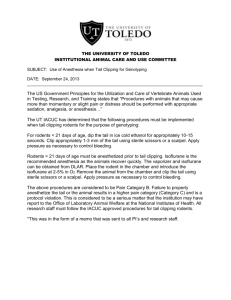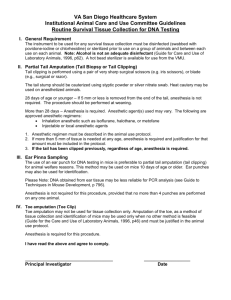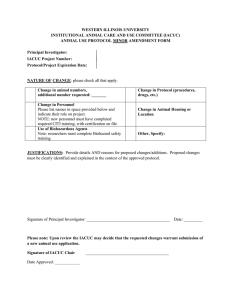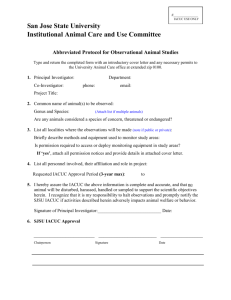IACUC Policy 17: Tail Snipping/Biopsy and Toe Clipping
advertisement
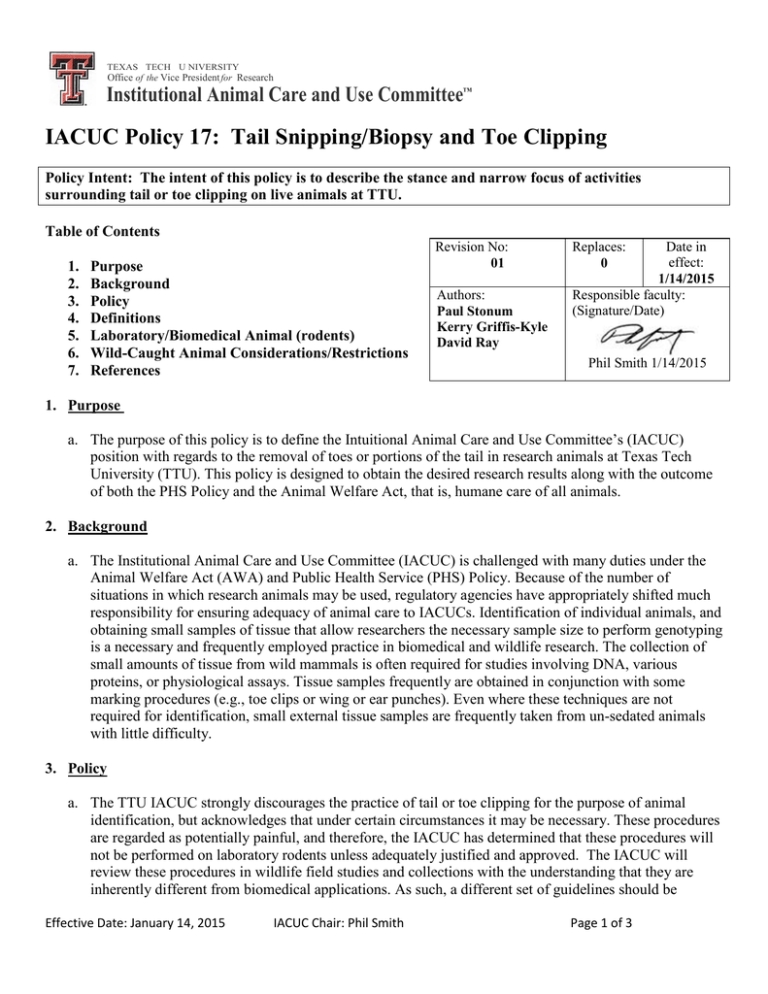
TEXAS TECH U NIVERSITY Office of the Vice President for Research Institutional Animal Care and Use Committee™ IACUC Policy 17: Tail Snipping/Biopsy and Toe Clipping Policy Intent: The intent of this policy is to describe the stance and narrow focus of activities surrounding tail or toe clipping on live animals at TTU. Table of Contents 1. 2. 3. 4. 5. 6. 7. Purpose Background Policy Definitions Laboratory/Biomedical Animal (rodents) Wild-Caught Animal Considerations/Restrictions References Revision No: 01 Authors: Paul Stonum Kerry Griffis-Kyle David Ray Replaces: 0 Date in effect: 1/14/2015 Responsible faculty: (Signature/Date) Phil Smith 1/14/2015 1. Purpose a. The purpose of this policy is to define the Intuitional Animal Care and Use Committee’s (IACUC) position with regards to the removal of toes or portions of the tail in research animals at Texas Tech University (TTU). This policy is designed to obtain the desired research results along with the outcome of both the PHS Policy and the Animal Welfare Act, that is, humane care of all animals. 2. Background a. The Institutional Animal Care and Use Committee (IACUC) is challenged with many duties under the Animal Welfare Act (AWA) and Public Health Service (PHS) Policy. Because of the number of situations in which research animals may be used, regulatory agencies have appropriately shifted much responsibility for ensuring adequacy of animal care to IACUCs. Identification of individual animals, and obtaining small samples of tissue that allow researchers the necessary sample size to perform genotyping is a necessary and frequently employed practice in biomedical and wildlife research. The collection of small amounts of tissue from wild mammals is often required for studies involving DNA, various proteins, or physiological assays. Tissue samples frequently are obtained in conjunction with some marking procedures (e.g., toe clips or wing or ear punches). Even where these techniques are not required for identification, small external tissue samples are frequently taken from un-sedated animals with little difficulty. 3. Policy a. The TTU IACUC strongly discourages the practice of tail or toe clipping for the purpose of animal identification, but acknowledges that under certain circumstances it may be necessary. These procedures are regarded as potentially painful, and therefore, the IACUC has determined that these procedures will not be performed on laboratory rodents unless adequately justified and approved. The IACUC will review these procedures in wildlife field studies and collections with the understanding that they are inherently different from biomedical applications. As such, a different set of guidelines should be Effective Date: January 14, 2015 IACUC Chair: Phil Smith Page 1 of 3 TEXAS TECH U NIVERSITY Office of the Vice President for Research Institutional Animal Care and Use Committee™ appropriately consulted, and justification for toe clipping as a means of identification should include consideration of the natural history of the species, how the feet are used in the animal’s environment, and the size of the toe. When approved, all activities surrounding tail or toe clipping shall assure appropriate animal welfare and minimizing pain and distress to the animal. 4. Definitions a. Tail snipping is the practice of removing roughly 1-2 millimeters or less of the tip of the tail and no ossified vertebral tissue, and is not necessarily considered a surgical procedure. The purpose of a tail snip is to obtain a small amount of tissue and/or blood (approximately 10 µl) for genotyping or other analysis and only involves the removal of the fleshy tail tip. When done properly, a tail snip is easy to perform and does not cause pain or distress, therefore, anesthetics and/or analgesics are not required for a tail snip. b. Tail biopsy, a more invasive procedure used only for genotyping, involves amputation of the tail between bony vertebral segments. This procedure is considered a painful procedure and requires anesthetics and/or analgesics, unless scientifically justified and approved by the IACUC. c. Toe clipping is the practice of removing the toe from the most distal joint to the tip of the toe. Toe clipping is not necessarily considered a surgical procedure. 5. Guidelines for Laboratory/Biomedical Animal (rodents) a. Tail Snipping i. This procedure causes minimal pain or distress, therefore, anesthetics and/or analgesics are not required for removal of the fleshy tail tip. ii. Should be performed using sharp scalpel blades, scissors or razor blades iii. It is recommended that no more than two tail snips are performed on a single animal iv. It is recommended that there is a minimum of two weeks in between tail snips to allow the animal to recover. v. Bleeding usually stops spontaneously, however to achieve adequate hemostasis, a cotton ball or piece of gauze may be applied using a small amount of pressure. vi. Animals shall be monitored for self-traumatization and or mutilation b. Tail Biopsy i. 5-10 days old – recommended age. No anesthesia required. ii. 10-21 days old (conduct as early as possible in this age range) • Local/Topical Anesthesia is Recommended. iii. Greater than 22 days of age • General Anesthesia Required unless the investigator provides adequate scientific justification and obtains IACUC approval. c. Toe Clipping i. Toe clipping of laboratory rodents is not recommended and will need adequate justification in an IACUC approved animal use protocol. Effective Date: January 14, 2015 IACUC Chair: Phil Smith Page 2 of 3 TEXAS TECH U NIVERSITY Office of the Vice President for Research Institutional Animal Care and Use Committee™ 6. Wild-Caught Animal Considerations/Restrictions a. Age Requirements i. None. • Identifying the age of non-juvenile animals in the field is often not possible. b. Toe clipping i. Toe clipping as a method of identification of small mammals (e. g. rodents and shrews), reptiles and amphibians shall only be used when no other individual identification method is feasible. ii. No more than 1 toe per foot may be clipped iii. Removal of the 1st digit (i.e. thumb) on either fore paw will not be allowed iv. Only removal of the 3rd phalanx (i.e. last bone of a digit) will be allowed v. Anesthetics and analgesics with regards to wildlife field studies are generally not recommended 7. References a. National Institutes of Health, ARAC, Guidelines for Toe Clipping of Rodents , Revised 6/13/07 b. Guide for the Care and Use of Laboratory Animals, 8th ed, National Research Council, National Academy Press, 2011, page 75 c. Sikes et al. 2011 J Mamm 92:235-253 d. Animal Welfare Information Center Bulletin, Summer 1999, Vol. 10 No. 1-2 e. http://www.nwhc.usgs.gov/ USGS National Wildlife Health Center Effective Date: January 14, 2015 IACUC Chair: Phil Smith Page 3 of 3
